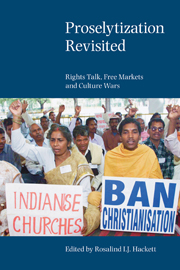Book contents
- Frontmatter
- Contents
- Preface and acknowledgements
- Contributors
- Revisiting Proselytization in the Context of Rights Talk, Free Markets and Culture Wars
- Section I
- Conflicts over Proselytism - An Overview and Comparative Perspective
- Conversion of the World: Proselytization in India and the Universalization of Christianity
- The Logic of Anti-proselytization, Revisited
- Section II
- Section III
- Section IV
- Section V
- Index
Conflicts over Proselytism - An Overview and Comparative Perspective
from Section I
- Frontmatter
- Contents
- Preface and acknowledgements
- Contributors
- Revisiting Proselytization in the Context of Rights Talk, Free Markets and Culture Wars
- Section I
- Conflicts over Proselytism - An Overview and Comparative Perspective
- Conversion of the World: Proselytization in India and the Universalization of Christianity
- The Logic of Anti-proselytization, Revisited
- Section II
- Section III
- Section IV
- Section V
- Index
Summary
“Missionaries are missionaries!” Such was the instant reaction of an Indian police official, speaking of missionary activities in his area, and whom I had asked to tell more precisely which missionaries he had in mind. Similar reactions can be observed in many places around the world. Whether it be Hindus, Buddhists, Muslims, Christians, or secularists, there are people of all persuasions who harbour suspicions about missionaries.
Conflicts over proselytism are not just an issue for non-Western countries. They are, in effect, a widespread phenomenon, the only difference being that people react in the name of their various ideologies or beliefs. In a number of Western countries, scholars have documented and analyzed over the past three decades a number of “cult” controversies. Those controversies—justified or not—represent reactions against missionary activities associated with non-conventional groups. Cults do not typically come under fire just because they propagate bizarre ideas, but because they convert people; parents worry about their sons and daughters choosing new lifestyles and orientations. The proselytizing activities and methods of cults are considered to be dishonest and subversive. They are often accused of making individuals into obedient zombies through mind control.
Another conflict over proselytism in the Western world has been the Islamic scarf controversy in France. Before the country decided to completely ban religious emblems, such as Islamic scarves and Sikh turbans, in French schools in 2004 (not in universities, however), there had been an initial decision to ban the scarf (in 1989) in cases where wearing it would “constitute an act of pressure, provocation, proselytism or propaganda”.
- Type
- Chapter
- Information
- Proselytization RevisitedRights Talk, Free Markets and Culture Wars, pp. 35 - 52Publisher: Acumen PublishingPrint publication year: 2008



